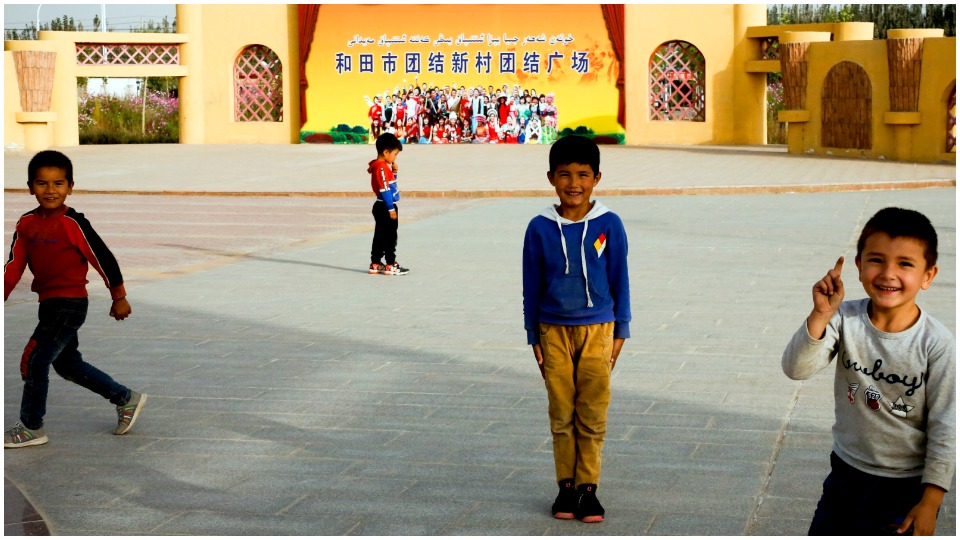
Editor’s Note: The following opinion article was written in response to Hanukkah: A holiday rooted in struggle against imperialism, which was published in People’s World on Dec. 23, 2019. That earlier article mentioned the situation for Muslims living in China’s Xinjiang region within the context of another topic; this contribution offers a more in-depth perspective on Xinjiang. As with all opinion articles published by People’s World, this article reflects the views of its author.
The People’s Republic of China is one of many developing countries of the global South seeking independence from the United States. It plays an important role in supporting global South cooperation and pointing toward a path of peaceful and independent development within the developing world. As the world’s largest developing country, led by a Communist Party, China is rightly seen by the U.S. ruling class as an existential threat to the never-ending dictatorial powers of the transnational corporations over global economic and political governance.
Since August 2018, the New York Times and other major U.S. and European media outlets, relying on thoroughly problematic sources, methods, and translations, have flooded the public with reports about China’s alleged campaign against the religion and culture of Uyghurs and other mainly Muslim ethnic minorities. The stories argue that hundreds of thousands, or even millions, have been held in “concentration camps” or “re-education camps,” and that China has forbidden ethnic minority Muslims from practicing their religion or using their own traditional languages. Supplementing these reports in the capitalist-owned media, stories of this type have been picked up without criticism by some popular progressive and left-wing publications.
A careful examination reveals that these accusations are closely linked to a decades-long, multi-pronged assault by U.S. imperialism on Muslims and perceived Muslims throughout Asia, Northern Africa, and the U.S. This strategy has included providing ultra-right Islamic groups with weapons, military training, and financial support in Muslim-majority countries as a policy of destabilization, then characterizing all Muslims as a terrorist threat, and finally using this as the justification both for the oppression of Muslims at home, and the invasion and occupation of Muslim-majority countries abroad.
These racist assaults were used as an important ideological pillar to justify and build popular support for the 2001 Authorization for Use of Military Force (AUMF) that enabled President George W. Bush to launch his “war on terror.” They were similarly key to the formation of the Department of Homeland Security, including ICE, and the passing of the anti-democratic Patriot Act. Raids and deportations in the communities and homes of Muslims and perceived Muslims soon followed, and the ICE terror has been expanded into other immigrant communities.
Building on the ideologies of “Yellow Peril” racism and anti-Communism, all of the racist ideas and policies used against Muslims in the name of “anti-terrorism” are being inverted for use against the People’s Republic of China. Within this narrative, Muslims and Uyghurs are the victims of Chinese racists and tyrants. The tactic draws on ideas which have been drilled into the minds of the U.S. people ever since Chinese immigrants were constructing the first transcontinental railroads in the U.S. And it utilizes the connected “Red Peril” version of anti-Chinese racism that has been around ever since the Communist Party of China became the main popular force in the fight against Japanese imperialism during World War II.
U.S.-backed fundamentalist extremism: From Afghanistan to Xinjiang
The Xinjiang Uyghur Autonomous Region of China is a diverse area in the northwestern part of China comprised of many ethnic groups, including Uyghurs, which are the largest, as well as peoples of Han, Kazakh, Hui, Mongolian, Kirgiz, Tajik, Xibe, Ozbek, Manchu, Daur, Tatar, and Russian background. Various religions co-existing side by side include Islam, Buddhism, Protestantism, Catholicism, Taoism, and Shamanism. It is a mountainous and remote region, sharing a border with many neighboring countries, including Afghanistan.
In July 1979, the U.S. began providing corrupt regional leaders and ultra-right Muslim guerrillas in Afghanistan known as the mujahideen with weapons, military training, and financial support. A section of mujahideen fighters eventually evolved into al-Qaeda, founded by Osama bin Laden in 1988. Afghanistan had a Communist-led government at that time, and the goal of the U.S. was to lure the neighboring Soviet Union into the “Afghan trap”—a proxy war that helped weaken the Soviet Union to the point of collapse.

Osama bin Laden, born into a wealthy Saudi family, had previously led the Saudi Arabian contingent of foreign Muslim “holy warriors” that went to fight the Soviets in Afghanistan. Despite Saudi Arabia’s known connections to al-Qaeda and the September 11th attacks on the World Trade Center, that theocratic monarchy never became a target of the so-called “global war on terrorism.” In fact, Saudi Arabia is the number one client of U.S. weapons manufacturers, and it is currently engaged in a genocidal slaughter of the Yemeni people.
Meanwhile, in Syria, Wikileaks cables from 2011 indicate the CIA was on the ground in that country manipulating the popular uprisings of the Arab Spring to topple the Syrian government. In 2009, Syrian President Bashar al Assad had refused to sign a pipeline agreement preferred by the U.S. A short time later, the U.S. was providing support to the anti-Assad “Free Syrian Army,” which was touted as a liberal democratic organization. In fact, the U.S. “was funding and training insurgents fighting alongside … al-Qaeda and al-Nusra.” In 2015, a U.S. general was forced to admit the Pentagon was only able to identify four “moderate” fighters among the U.S.-backed rebels in Syria.
A similar story has played out in Iran for decades. Dan Kovalik notes in his book The Plot to Attack Iran that “the United States’ long track record of working with radical religious groups to destroy the left,” including the Tudeh Party of Iran, “has played no small role in the rise of Islamic fundamentalism.”
When similar types of groups began spreading throughout Northern Africa, it created the perfect excuse for G.W. Bush to found AFRICOM in 2007, greatly increasing the presence of U.S. military bases in a number of African nations.
And that brings us to China. Between 1990 and 2016, the Xinjiang region was shaken by thousands of terrorist attacks traced to the East Turkestan Islamic Movement (ETIM). According to a 2019 documentary on Chinese television network CGTN, leading members of this group met with Osama bin Laden in the late 1990s, requesting training and economic aid. Other members have fought with al-Qaeda in Syria and other countries “for so-called battle practice” before returning to Xinjiang.

The U.S. has provided ideological support to separatist movements in Xinjiang through various “non-governmental organizations,” like the World Uyghur Congress, an outfit funded by the National Endowment for Democracy, long a front group for U.S. interference in other countries’ affairs.
ETIM was designated a terrorist organization by the United Nations in 2002. It calls for the separation of Xinjiang from the rest of China in order to establish an ultra-right theocratic state. Luring people in with the promise of paradise, the ETIM has assaulted traditional Uyghur culture by forbidding people from making music, drinking wine, singing and dancing, or crying at funerals. ETIM also proclaims that taking out bank loans or allowing women to work and earn money is not permissible, not halal.
Within all religions, there are both progressive and reactionary trends. None are immune to distortions by extremist and theocratic ideas that aim to take human society back to pre-feudal slave orders, or that seek to establish repressive and expansionist clerical states—whether they be the Hindu chauvinist BJP of India, the Wahhabist monarchy in Saudi Arabia, the ultra-right religious allies of the Israeli Likud, or the GOP-aligned “evangelical” Christian far-right and Trump-emboldened KKK and other “Christian” white nationalist hate groups. All of these are supported by major sections of the U.S. ruling class, especially the gun lobby and those investing in the manufacture of weapons and munitions, not to mention oil.
Socialist Xinjiang
But separatist groups in Xinjiang do not represent the vast majority of people in the region who cherish peace.
Xinjiang has been a part of China since the 1750s. In 1884, it became a full province. Before the socialist revolution and establishment of the People’s Republic in 1949, life expectancy in Xinjiang was 30 years. Most of the arable land was owned by a small number of landlords. As in Tibet, where a theocratic landlord class maintained a cruel system of feudal rule, landlords in southern Xinjiang owned the serfs working the land from head to foot. Some 90% of the population was illiterate, and less than 20% of children were in school.

After liberation in 1949, ordinary people received their own land, and a system of regional autonomy was implemented in 1955. Religious traditions have been re-aligned with the goals of the socialist state, and public services have been steadily built up.
Various affirmative action programs have been implemented for ethnic minorities in family planning, education, employment, and political representation. Xinjiang was China’s first province to offer 15 years’ free education. Today, life expectancy is more than 72 years. Illiteracy is below 2%, and school enrollment tops 99%. In Tibet, the first region of China to eliminate extreme poverty, life expectancy has nearly doubled.
According to a 2019 Xinhua report, the central government has invested about 2.35 trillion yuan (nearly $337 billion in 2020 USD) in Xinjiang over the past 70 years. “Urban and rural per capita disposable incomes both surged more than 100 times from 1978 to 2018. [In 2018], the figures were 32,764 yuan ($4,700 USD) and 11,975 yuan ($1,700 USD), respectively.” A total of 2.3 million people in Xinjiang escaped poverty between 2014 and 2018. Last year alone 645,000 people were lifted out of poverty.
There are over 24,000 mosques in Xinjiang, more than two-thirds of the more than 35,000 mosques built throughout the country. Compare this with the 2,106 mosques built in the United States. This means that, on a per capita basis, Chinese Muslims have about 2.5 times as many mosques as Muslims in the U.S.

After liberation, the Chinese state helped many ethnic minorities develop their own written languages, and China aims to ensure all children in Xinjiang have access to bilingual education by the end of this year.
There are eight religious colleges in Xinjiang, including the Xinjiang Islamic Institute and Xinjiang Islamic School, and 112 other religious organizations. The Koran and other religious texts have been translated into the Uyghur, Mandarin Chinese, Kazakh, and Kirgiz languages. Since 1996, the Chinese government has been organizing hajj trips to Mecca so that Chinese Muslims can make their pilgrimages. Doctors, chefs, tour guides, and translators also attend these trips to provide necessary services.
The PRC Constitution protects minorities’ right to vote and stand for election, and the Communist Party of China has raised the number of ethnic minority cadre (Communist Party officials) in Xinjiang from 3,000 in 1950 to 428,000 in 2018. There are now 2.9 million ethnic minority cadres in China overall.
Challenges for future development
However, Xinjiang remains among the most underdeveloped regions of China. Xinjiang’s capital, Urumqi, is the farthest city from any ocean in the world, cutting it off from sea-based trade routes.
There are also complex social realities. Some older generations of people in Xinjiang are used to the traditional nomadic way of life of a herder, while many younger people are anxious to join the modern world. At the same time, unemployment has plagued the lives of many young people, and economic desperation has left some vulnerable to the influence of extremist ideologies.

In China, economic well-being is the primary human right. In the face of serious security challenges, the People’s Republic has identified poverty as the root cause of instability. While there has been a strong law enforcement response to acts of terrorism and investigations into terrorist organizations, the priority of the Chinese government has been prevention, combining anti-terrorism efforts with poverty alleviation, including housing construction, job creation, and training in useful skills to help people find employment and start new businesses.
Vocational education centers have been set up for people to be trained in various vocational skills of their choice, to study Chinese laws and understand their political rights, and to learn Mandarin Chinese. President of the Xinjiang Islamic Institute Abudulrekep Tumniaz has insisted that, “For the 56 ethnic groups to achieve close solidarity, we must be able to communicate.”
In addition, the vocational schools have included the component of winning people away from extremist ideas. “Islam is a proponent of peace,” says Tumniaz. “Peace is the name of our faith, which embodies peace itself.”
Since 2016, when the program started, there have been no terrorist attacks in Xinjiang. Tourism is now becoming an important spur to economic and cultural development.
On invitation from the Chinese government, UN officials from a number of different countries visited Xinjiang to witness the situation. 37 countries—including Cuba, the pre-coup Morales government in Bolivia, Venezuela, Libya, Angola, Nigeria, and many other countries of the global South—expressed their support for China’s fight against terrorism in July 2019. In October, 54 countries, including more than a dozen member countries of the Organization of Islamic Cooperation, voiced their support in the United Nations for China’s approach to the fight against terrorism. This was in response to a statement made by a UK representative on behalf of 23 countries, including the U.S., with their allegations against China in the international body. Even CNN has acknowledged that allegations of human rights violations in China have all come from “Western” governments and organizations—that is, from the U.S., European capitalist powers, and their allies—all majority-white nations, with the exception of Japan.
Independent and leftist journalists from 24 countries have also visited Xinjiang and noted the PRC’s support for its thriving ethnic minority and Islamic cultures and the progressive social programs being implemented there.
Xinjiang is also becoming a major hub for the Belt and Road Initiative, which aims to improve connectivity between Asia, Africa, and Europe, boosting economic development and international cooperation. High-speed passenger rails, commercial rail lines, and roads are being constructed in Xinjiang, connecting the region with the eastern coast of China, and a “dry-port” has been built in Khorgas, integrating the land-locked Kazakhstan into major transport routes.
In July 2019, a Global Times article reported that 90% of all graduates in the education and training programs in Xinjiang have found good jobs. In December 2019, regional officials in China said that all the trainees have graduated.
The need for a better understanding of China by the people of the United States was highlighted again in late January when the U.S. House of Representatives passed the Tibetan Policy and Support Act of 2019. In November 2019, the House passed the so-called Hong Kong Human Rights and Democracy Act of 2019. After the Senate passed the Uyghur Human Rights Policy Act of 2019 in December, introduced by the fascist-minded Marco Rubio, religious leaders in Xinjiang voiced their firm opposition.
These bills call on the president (i.e. Trump) to funnel financial support into unnamed “non-governmental organizations” to implement sanctions and other meddling actions, including a call for measures that would threaten to drive a wedge between China and the recently elected Communist-led government in Nepal. Nearly every Democrat voted for all of these bills, including many otherwise progressive figures.
Once again, we are falling for tired lines about “freedom,” “democracy,” and “human rights” to excuse the mechanizations of U.S. imperialism in its relentless drive to maximize the profits and power of U.S. corporations. The fight for peace is incomplete without a vigorous defense of the right of nations to self-determination. The commitment to a foreign policy of non-interference must be demanded from the U.S. people as this will provide the strongest basis on which the peoples of the world can carry on their struggles for a form of working-class democracy that best suits their own national conditions.
Meanwhile, we continue the fight for democracy here in the United States.
For further reading on China, here is a topically organized document with links to various articles and other information resources. The author also thanks Prof. Norman Markowitz for his suggestions and comments on the article.










